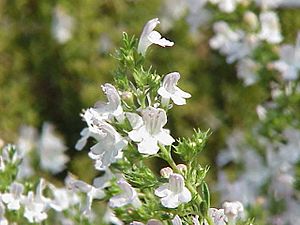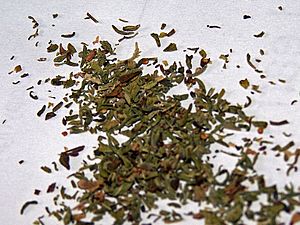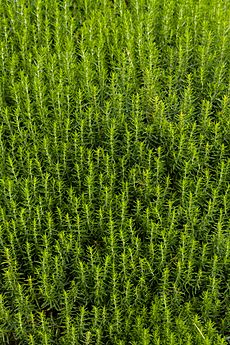Satureja facts for kids
Quick facts for kids Satureja |
|
|---|---|
 |
|
| Winter savory, Satureja montana | |
| Scientific classification |
|
| Kingdom: | Plantae |
| Clade: | Tracheophytes |
| Clade: | Angiosperms |
| Clade: | Eudicots |
| Clade: | Asterids |
| Order: | Lamiales |
| Family: | Lamiaceae |
| Subfamily: | Nepetoideae |
| Tribe: | Mentheae |
| Genus: | Satureja L. |
| Synonyms | |
|
|
Satureja (say "Sat-ur-AY-jah") is a group of plants that smell nice. They are related to rosemary and thyme. These plants grow naturally in North Africa, southern Europe, the Middle East, and Central Asia.
Some types of Satureja are grown as cooking herbs. They are called savory. You might find them growing wild in some places too.
Contents
What Savory Plants Look Like
Satureja plants can be annuals (they live for one year) or perennials (they live for many years). They are small plants, like herbs or small subshrubs. They usually grow to be about 15 to 50 centimeters (6 to 20 inches) tall.
Their leaves are about 1 to 3 centimeters (0.4 to 1.2 inches) long. The flowers grow in circles around the stem. They can be white or a light pink-purple color.
Growing Savory and Nature's Role
Savory plants are important food for the caterpillars of some Lepidoptera (which are butterflies and moths). For example, the caterpillar of the moth Coleophora bifrondella eats only winter savory.
You can grow savory plants just because they look pretty. They need a sunny spot and soil that drains water well.
How We Use Savory

Two main types of savory are used in cooking: summer savory (Satureja hortensis) and winter savory (Satureja montana). Cooks often like summer savory more. But it's an annual, so it only grows in summer. Winter savory is a perennial and stays green all year.
Savory is a big part of cooking in places like Armenia, Georgia, Bulgaria, and Italy. It's especially popular for flavoring beans. It's also used in a traditional stew from Acadia called fricot. Savory is also a key spice in sarmale, a dish with stuffed cabbage from Romania. The famous spice mix Herbes de Provence also has savory as one of its main ingredients.
In Azerbaijan, people often add savory to their black tea for flavor.
Types of Savory Plants
There are many different kinds of Satureja plants. Here are a few examples:
- Satureja adamovicii Šilic – Found in the Balkans.
- Satureja hortensis L. – This is summer savory. It grows in many parts of Europe and Asia. It has also spread to other places like Cuba and parts of the United States.
- The natural oils from summer savory can even be used to help stop weeds from growing. They can make it harder for weed roots to grow and for the weeds to sprout.
- Satureja khuzistanica Jamzad – Found in Iran.
- The natural oils from Satureja khuzistanica might help with swelling and could be useful in medicine. One study showed these oils helped reduce bad effects from brain injuries in rats.
- Satureja montana L. – This is winter savory. It grows in southern Europe, Turkey, and Syria.
- Satureja subspicata Bartl. ex Vis. – Found in Austria and other parts of Europe.
Where the Name "Satureja" Comes From
The exact meaning of the Latin word "satureia" is not fully known. Some people think it might be linked to words like saturare (to fill up) or even to the mythical creature satyr. It might also be related to the Middle Eastern spice called za'atar. The old Hebrew name for this plant is Tzatrah.
Images for kids
See also
 In Spanish: Saturejas para niños
In Spanish: Saturejas para niños



